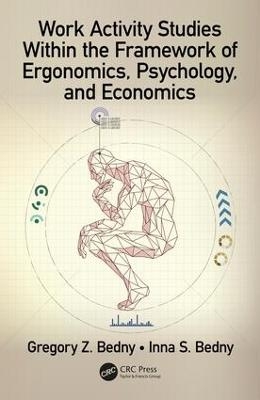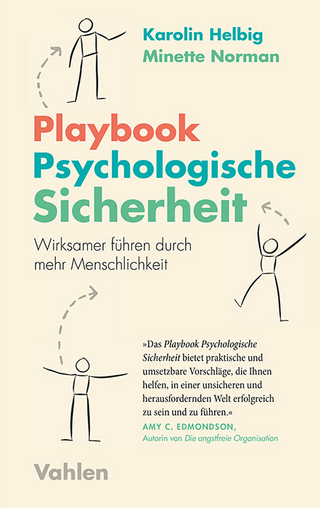
Work Activity Studies Within the Framework of Ergonomics, Psychology, and Economics
Crc Press Inc (Verlag)
978-0-8153-5710-0 (ISBN)
Systemic-structural activity theory (SSAT), founded by Gregory Bedny, is a relatively new unified framework for the study of efficiency of human performance, equipment, and software design. This book presents new recently obtained data in the field of SSAT that can be used in the study of efficiency and complexity of human performance. With increased cognitive demands to task performance, psychological methods of study of human activity play an important role. New principles and revised methods for the study of human work are supplemented by practical examples in manufacturing, construction industry, aviation, and human-computer interaction.
Features:
Presents new SSAT data
Offers, for the first time, comparative analysis of studying efficiency and productivity from the perspective of ergonomics, psychology, and economics
Includes examples of evaluation of economic efficiency of ergonomic innovations
Provides advanced self-regulative models of activity and of all cognitive processes that describe strategies of task performance
Introduces a new efficient method of morphological and analytical quantitative analysis
Discusses new methods of evaluation of complexity and reliability of highly variable computerized and computer-based tasks
Work Activity Studies Within the Framework of Ergonomics, Psychology, and Economics presents a comprehensive unified psychological theory that can be utilized as a general approach to the study of human activity not only for ergonomists and psychologists, but also for economists that study the efficiency of human performance.
Dr. Gregory Bedny has taught psychology at Essex County College and now he is a Research Associate at Evolute, Inc. Dr. Bedny earned PhD in Industrial Organizational and a Post-Doctorate Degree (ScD) in Experimental Psychology. He is also a board-certified ergonomist. He has authored and co-authored 6 original scholarly books in English published between 1997 and 2015 by Lawrence Erlbaum Associates, Inc., Taylor and Francis Group and CRC Press. Dr. Bedny has developed Systemic-Structural Activity which is the high-level generality theory that offers unified and standardize methods of the study of human work. He applied his theoretical studies in the field of human-computer interaction, manufacturing, merchant marines, aviation and transportation, robotic systems, work motivation, training, reducing fatigue. Dr. I. S. Bedny is a computer professional with Ph.D. in Experimental Psychology. She is doing research applying SSAT to Human Computer interaction. She is the author or co-author a number of scientific publications in the field of HCI. In 2015, she has co-authored the book Applying Systemic-Structural Activity Theory to Design of Human-Computer Interaction Systems published by CRC Press. She also has experience teaching math and physics at a high school level and training computer professionals. Dr. I. Bedny is also a Research Associate at Evolute, Inc.
PART 1, Section I. The role of ergonomics, psychology and economics in studying efficiency of human performance , 1.1. Brief history of human performance analysis , 1.2. Study of human performance in ergonomics, psychology and economics , 1.3. Examples of evaluation of economic efficiency of innovations, Section II. Concept of task in systemic-structural activity theory , 2.1. Overview of systemic-structural activity theory, 2.2. Analysis of the basic components of the tasks, 2.3. Cognitive and behavioral actions as basic element of task , 2.4. Task classification and design, 2.5. Study of production process in the construction industry by using technological units of analysis, Section III. Concept of activity as self-regulative system and its role in study pilot’s performance, 3.1. Concepts of orienting activity and situation awareness: comparative analysis., 3.2. Self-regulation model of orienting activity in systemic-structural activity theory, 3.3. Examples of studies pilot’s activity in emergency situations from the functional analysis perspective, 3. 4. Analysis of pilot strategies when engines can fail , 3.5. Example of eye movement analysis in pilots’ performance, Section IV. Concept of self-regulation of cognitive processes in systemic-structural activity theory , 4.1. Self-regulative models of perceptual process , 4.2. Self-regulation model of memory, 4.3. Applying experimental methods to study of attention, 4.4. Self-regulation model of attention, 4.5. The role of thinking in the study of human performance, 4.6. Self-regulation model of thinking , Section V. Tasks with complex logical and probabilistic structure and assessment of the probability of decision making outcomes , 5.1. Problem solving and decision-making tasks, 5.2. Decision-making in rule-based or instruction based tasks, 5.3. New method of assessing probability of decision making outcomes in task analysis, PART II, Design of computerized and computer based tasks with variable structure , VI. Morphological analysis of activity, 6.1. Introduction to morphological analysis of task performance, 6.2. Description of individual members of an algorithm, 6.3. Algorithmic description of activity as basis of analysis of variable tasks, 6.4. Development of the activity time structure, 6.5. Pace of task performance and the process of its formation, Section VII. Design of Computerized Tasks with Complex Logical and Probabilistic Structure, 7.1. Qualitative analysis of a computerized task, 7.2. Morphological analysis of computerized task with complex probabilistic structure, 7.2.1. Morphological analysis of subtask 0 , 7.2.2. Morphological analysis of Version 1 of Inventory Receiving task performance , 7.2.3. Morphological analysis of Version 2 of task performance, 7.2.4. Morpphological analysis of Version 3 of task performance , Section VIII. Quantitative assessment of complexity of computerized tasks., 8.1. Basic principles of measuring the task complexity, 8.2. Quantitative assessment of task complexity, 8.3. Evaluation of the computerized task complexity before and after innovation , 8.3.1.. Evaluation of the first version of tasks complexity before and after innovation, 8.3.2.. Evaluation of the second version of tasks complexity before and after innovation, 8.3.3. Evaluation of the third version of tasks complexity before and after innovation, Section IX. Assessment of complexity and reliability of computer based task with complex logical and probabilistic structure, 9.1. Assessment of reliability of computer based task before innovation, 9.2. Assessment of reliability of computer based task after innovation , 9.3. Complexity evaluation of computer based task before innovation, 9.4. Complexity evaluation of computer based task after innovation, 9.5. Economic effects of implemented innovations, Conclusion, Bibliography, Index,
| Erscheinungsdatum | 25.09.2018 |
|---|---|
| Reihe/Serie | Human Activity |
| Zusatzinfo | 35 Tables, black and white; 76 Line drawings, black and white; 6 Halftones, black and white; 82 Illustrations, black and white |
| Verlagsort | Bosa Roca |
| Sprache | englisch |
| Maße | 156 x 234 mm |
| Gewicht | 840 g |
| Themenwelt | Geisteswissenschaften ► Psychologie ► Arbeits- und Organisationspsychologie |
| Mathematik / Informatik ► Informatik | |
| Technik | |
| ISBN-10 | 0-8153-5710-9 / 0815357109 |
| ISBN-13 | 978-0-8153-5710-0 / 9780815357100 |
| Zustand | Neuware |
| Informationen gemäß Produktsicherheitsverordnung (GPSR) | |
| Haben Sie eine Frage zum Produkt? |
aus dem Bereich


